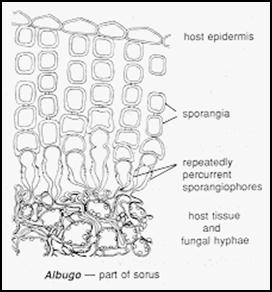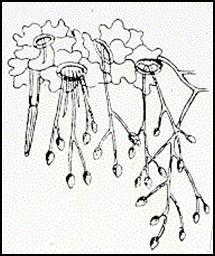


 النبات
النبات
 الحيوان
الحيوان
 الأحياء المجهرية
الأحياء المجهرية
 علم الأمراض
علم الأمراض
 التقانة الإحيائية
التقانة الإحيائية
 التقنية الحيوية المكروبية
التقنية الحيوية المكروبية
 التقنية الحياتية النانوية
التقنية الحياتية النانوية
 علم الأجنة
علم الأجنة
 الأحياء الجزيئي
الأحياء الجزيئي
 علم وظائف الأعضاء
علم وظائف الأعضاء
 الغدد
الغدد
 المضادات الحيوية
المضادات الحيوية|
Read More
Date: 2025-01-11
Date: 17-11-2015
Date: 22-3-2016
|
Phylum. Oomycota
Order: Peronosporales (Downy mildews)
This group contains the most advanced Oomycota. They are mostly obligate parasites on the aerial parts of higher plants. This order contains many destructive parasites of economic plants, and causes tremendous losses in crops each year. Since their spores are wind borne, their sporangia are not unspecialized hyphal tips, but borne on branched aerial asexual "sporangiophores", which produce asexual spores,There are also sexual sporangia borne on"sporangiaophores".
Albuginaceae:
Albugo candida:
Otherwise known as a "white rust" (cause White rust of crucifers) which produces whitish coloured blisters on the surface of its host. These blisters contain innumerable unicellular mitosporangia (sporangia that produce spores by mitosis) that develop in chains from the tips of short tightly packed sporangiophores . When the host epidermis bursts, the sporangia are wind- or rainsplash-dispersed to other host plants, where each can germinate to release eight biflagellate zoospores. Oogonia develop later, inside the host stem or leaves, and sexual reproduction is usually heterothallic.
 |
||||
|
|
||||

Pythiaceae:
Phytophthora infestans (the cause of late blight of potato).
The mycelium penetrates plant tissue, eventually killing it. This genus produces sporangium outside the plant( The lemon-shaped ,papillate sporangia are borne at the tips of the sporangiophore branches). The sporangia are held out from the surface of the plant by sporangiophore which grows through the stomata (small pore on leaf/stem surface). Several flagellate zoospores are produced within each sporangium. These zoospores are most effective in infecting other plants if transferred in wet conditions.
Peronosporaceae
Peronospora parasitica:
The fungus causing downy mildew in crucifers. the sporangiophores cover the surface of the leaves and stems of the infected plants, giving them a "downy" appearance.( the parasitized cells are not killed) . after few days of vegetative activity within the host, reproductive structures are formed. These are branched sporangiophore ,each emerges through a stoma and has an un branched lower region and a branched upper one with fine ends each bearing an oval sporangium.

Live Material
Saprolegnia
Place about a teaspoon of the mud in the bottom of a culture dish. Add sufficient water to cover the mud to a depth of one cm. Float some Sesame seeds on the surface and cover with plastic wrap to limit evaporation. Leave for one week. After a week, lift the Sesame seed and transfer to a clean petri dish. Add 10 ml of sterile
lake water to the petri and cover. Place in a dark cupboard for another week. Select seeds that have a mass of white "wool" growing out of them. Make a wet mount slide and examine for antheridia and oogonia.



|
|
|
|
4 أسباب تجعلك تضيف الزنجبيل إلى طعامك.. تعرف عليها
|
|
|
|
|
|
|
أكبر محطة للطاقة الكهرومائية في بريطانيا تستعد للانطلاق
|
|
|
|
|
|
|
العتبة العباسية المقدسة تبحث مع العتبة الحسينية المقدسة التنسيق المشترك لإقامة حفل تخرج طلبة الجامعات
|
|
|